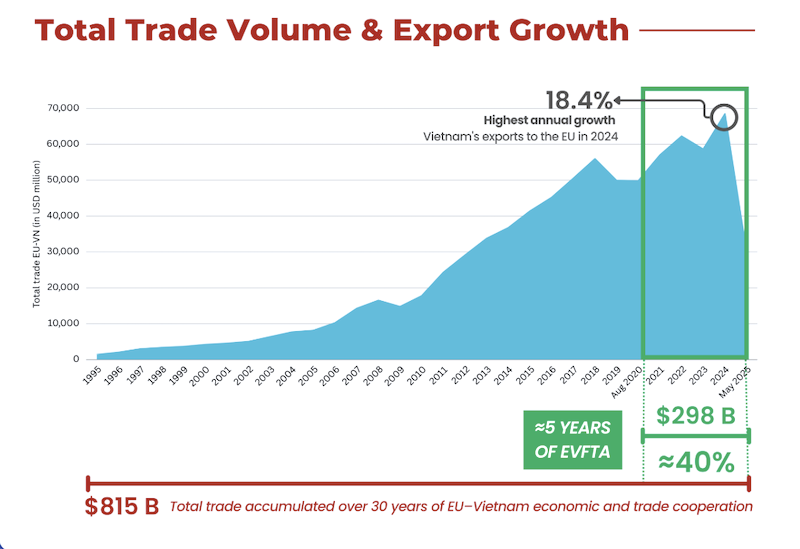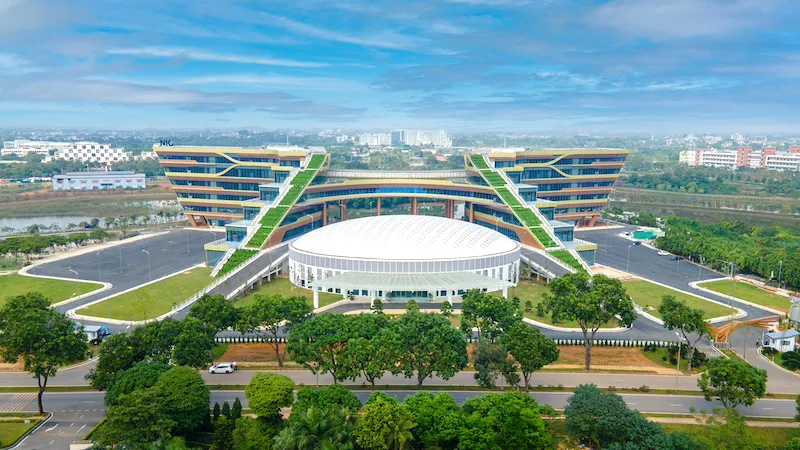Vietnam poised for sustainable growth through green cooperation: EuroCham
Vietnam’s push for green cooperation is seen as the cornerstone of its sustainable growth.
With bold administrative reforms, digital transformation, green growth commitments, and a young workforce, Vietnam is emerging as an attractive destination ready to deepen cooperation with Europe for sustainable, inclusive growth, Bruno Jaspaert, Chairman of the European Chamber of Commerce in Vietnam (EuroCham), told The Hanoi Times.
How do you view Vietnam’s economic prospects in 2025 given the recent GDP growth forecast upgrades?
With comprehensive development projects backed by the government, I believe Vietnam is well-positioned to push towards its ambitious growth targets this year.

Bruno Jaspaert, Chairman of the European Chamber of Commerce in Vietnam
In an era of global trade uncertainty, foreign investment will remain important, but unlocking more of Vietnam’s domestic potential will be equally critical to sustaining momentum.
The recent US “reciprocal tariff” decision - now set at 20% for Vietnam, down from the threatened 46% - aligns with regional peers and should ease the potential impact.
Even at the higher rate, our Q2/2025 EuroCham survey showed 70% of European firms reported no financial impact, 15% saw a hit, and 5% even recorded net gains. This suggests the final rate will have only a mild effect, and tariffs, like most things, are a double-edged sword.
What matters most is the long-term strategy Vietnam carves out for itself. After seven years here, I can say with confidence that very few countries match Vietnam’s resilience.
Its fundamentals are enviable: a low public debt-to-GDP ratio among nations of similar population size, rare earth reserves vital to high-tech and renewable industries, and strong food self-sufficiency. These factors underpin both economic stability and growth potential.
The real question is no longer whether Vietnam has potential, but how it will fully capitalize on its “growing value.” By boosting domestic investments and strengthening supply chains, Vietnam can reduce tariff exposure while capturing new markets.
Tariffs may hurt some low-margin sectors and prompt certain relocations, but history shows Vietnam has overcome far greater challenges.
In 2024, GDP still expanded by 7.09% despite Typhoon Yagi, while EuroCham’s Business Confidence Index rose to a two-year high of 61.8, up 33% year-on-year.
Looking ahead, rules of origin will be key to strengthening the "Made in Vietnam" brand, boosting local sourcing, and deepening supply chain integration.
Major infrastructure projects - from 3,000 km of new expressways and a cargo railway linking Lao Cai, Hanoi and Haiphong, to metro expansions in Ho Chi Minh City and the completion of Long Thanh International Airport - together with ongoing administrative, green and digital reforms, will help transform this “era of rising” into enduring prosperity.
With 78% of EuroCham members expecting improved conditions over the next five years, confidence in Vietnam’s adaptability and long-term success remains high.
Beyond the EVFTA’s five-year milestone, what other factors are shaping EU-Vietnam trade and investment ties?
Five years on, the EU-Vietnam Free Trade Agreement (EVFTA) has driven nearly US$300 billion in trade, almost 40% of all trade between the EU and Vietnam since 1995.
On its progressive path to eliminate up to 99% of import duties, the EVFTA has boosted market access and delivered tangible business gains, with average revenue increases of 8.7% and top performers seeing growth of up to 25%.

Screenshot of EuroCham’s report: EVFTA at a glance
Today, the EU-Vietnam cooperation goes far beyond tariff reductions. Shared priorities like climate resilience and sustainability are defining the next chapter, guided by frameworks such as the European Green Deal, the Carbon Border Adjustment Mechanism (CBAM), and the EU Deforestation Regulation (EUDR).
This year, the Just Energy Transition Partnership (JETP) alone has identified 24 green projects, including three currently under review for $7 billion in funding-from upgrading Tri An hydropower to building large-scale energy transmission lines through Ho Chi Minh City.
EuroCham remains committed to serve as a bridge in translating these policies into real opportunities, connecting European expertise with Vietnam’s development priorities.
Through platforms like the Green Economy Forum (GEF), the focus is now on ensuring that the EU-Vietnam trade grows in volume, and advances in sustainability, innovation, and resilience, making this partnership a model for rules-based, future-proof economic cooperation.
This year’s GEF edition, under the theme "Shaping Changes, Building Futures", will take place on November 27 in Hanoi. We hope to see all of you there, joining the dialogue on how to power Vietnam’s sustainable growth.
Which sectors offer the strongest growth opportunities for European businesses in Vietnam?
European businesses see the strongest opportunities in sectors where sustainability and innovation align with Vietnam’s development priorities.
Renewable energy leads the way, with European companies driving wind, solar and hydro projects that meet rising energy demand while cutting carbon emissions.

Hanoi-based National Innovation Center uses ABB's energy management and smart building technology for optimum efficiency, sustainability. Photo: ABB Vietnam
In green finance, investors are funding climate-resilient infrastructure and eco-industrial parks, while the establishment of IFC offices in Ho Chi Minh City and Danang, combined with the recent provincial mergers, could streamline governance and make Vietnam an even more attractive FDI destination.
The challenge now is ensuring effective implementation of these promising initiatives.
Smart agriculture is another high-growth area, with EU agri-tech solutions improving yields, quality, and environmental performance - vital for a nation that is both a major food exporter and highly vulnerable to climate change.
Niche sectors like eco-tourism also hold potential, capitalizing on Vietnam’s natural beauty while promoting environmental preservation.
The latest policy on relaxation and liberalization of visa waivers for European countries is a commendable step that will help attract more high-value visitors.
I also see immense potential in high-tech manufacturing, particularly in the semiconductor sector.
Vietnam has a clear ambition to become a regional hub, with a dedicated development strategy to participate in all stages of the global semiconductor supply chain, from assembly and testing to higher-end chip design and R&D.
Beyond that, significant opportunities exist in public transport.
Hanoi and Ho Chi Minh City are investing heavily in extensive metro and light rail networks.
On a national level, projects like the North-South High-Speed Railway and Kunming-Lao Cai-Haiphong lines are creating demand for advanced technology and project management expertise, where European firms can contribute to transforming how people and goods move across the country.
These opportunities thrive because of shared commitments to sustainability, supportive government policies, and Vietnam’s strategic ASEAN location.
By pairing European expertise with Vietnam’s young, skilled workforce, and backing it with clear, consistent regulations, these collaborations can scale across the economy, accelerate the green transition, enhance competitiveness, and create sustainable, long-term growth.
What challenges remain for EU investors? How can they be addressed?
Work permits have long been a concern for foreign investors, and in 2025, EuroCham identified them as one of our must-win battles.
Encouragingly, the government has approved new regulations exempting high-level executives and senior experts from the administrative process of applying for a work permit.
The reforms also allow online applications and approvals at the provincial level, removing the need for central authorization.
This is a progressive step that addresses several pain points for the international business community, and EuroCham will continue working with both the authorities and businesses to ensure effective implementation, so the benefits are felt across the board.
That said, Vietnam still faces some persistent challenges that limit its full potential. Regulatory ambiguities such as conflicting renewable energy procurement rules create uncertainties, while bureaucratic inefficiencies, from slow permit approvals to inconsistent enforcement, delay projects.
Infrastructure gaps, especially in grid capacity, hinder renewable energy growth, and skilled labor shortages in technical fields add further pressure.
Overcoming these barriers requires a comprehensive reform agenda: streamlining regulations, modernizing infrastructure, ensuring reliable green energy, and investing in human capital through targeted training with European partners. Public-private partnerships can be instrumental in achieving these goals.
The Vietnamese government has already taken concrete steps in this direction, giving us every reason to be optimistic about building a stronger, more efficient, and investment-friendly system in the near future.
EuroCham stands ready to help, through our whitebook, must-win battles and ongoing advocacy, and ensure Vietnam competes and leads in the regional and global economy.
How can the EU and Vietnam deepen cooperation in green growth and innovation?
The EU and Vietnam have a powerful opportunity to align on green growth and innovation. European companies bring expertise in renewable energy, circular economy solutions, and sustainable manufacturing, and many are already applying these in Vietnam.
In sectors such as sustainable agriculture, digitalization, and green energy, European expertise complements Vietnam’s resource base and development priorities.
For instance, European innovations in digitalized, sustainable farming are enhancing productivity and quality across Vietnam’s agri-food and aquaculture sectors, areas where Vietnam remains a vital supplier to the European market.
At the same time, the EVFTA positions Vietnam as a reliable alternative hub in an increasingly disrupted global trade environment.
Platforms like EuroCham’s Green Economy Forum (GEF) connect these innovations with Vietnamese policymakers, businesses, and communities.
Looking ahead, deepening cooperation will require tackling regulatory bottlenecks, expanding renewable infrastructure, and supporting digital transformation.
High-potential sectors include advanced manufacturing, data centers, and eco-tourism, alongside renewable energy.
By pairing European sustainability expertise with Vietnam’s young, tech-savvy workforce and reform-driven agenda, both sides can ensure that economic growth is inclusive, resilient, and future-ready, positioning Vietnam as a leader in the global green and digital economy.
Thank you for your time!








